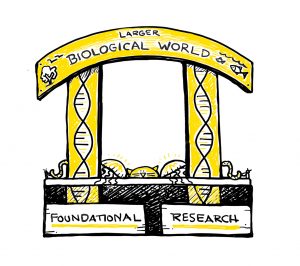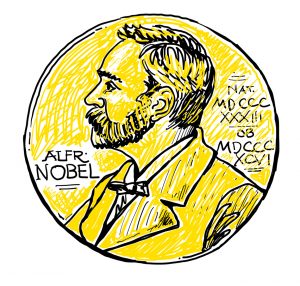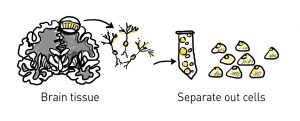An Everyday DNA blog article
Written by: Sarah Sharman, PhD, Science writer
Illustrated by: Cathleen Shaw
Two years ago, I moved into a brand-new house in a developing neighborhood. Our house is on the edge of the completed phase of houses and the next phase of development. Consequently, I get to watch a lot of houses built literally from the ground up. The builders spend a long time flattening the ground, packing down dirt, and creating a flat and stable foundation for the house.
A solid foundation is important because it must hold the weight of the house while staying in place during windy weather, excess rainfall, and ground movement from construction blasting or small earthquakes. Without a sturdy base to build upon, we wouldn’t have many of the iconic buildings in our world today.
The same is true about scientific research. Researchers would not have made some of the monumental breakthroughs in human health and disease without a foundational knowledge of the inner workings of organisms, cells, and DNA. This field of study, called foundational science research, lays the groundwork for translational science that takes findings from the lab and applies them to solutions for problems in our world. Let’s learn more about this important field and how foundational discoveries helped drive some of the most consequential discoveries of our time.
What is foundational research?
 Foundational science research, also called basic science research, is anything but basic. The goal of foundational research is discovery. It generates new knowledge that helps us understand the fundamental principles of nature. The valuable information acquired from foundational research serves as the building blocks for solving many problems in human health and welfare, from disease to climate change.
Foundational science research, also called basic science research, is anything but basic. The goal of foundational research is discovery. It generates new knowledge that helps us understand the fundamental principles of nature. The valuable information acquired from foundational research serves as the building blocks for solving many problems in human health and welfare, from disease to climate change.
Curious, creative, and dedicated foundational researchers ask fundamental questions about the biological world, create hypotheses, test the hypotheses, and analyze research results. The advancement of knowledge in foundational science does not always come quickly, sometimes taking years or decades to become a clear finding. Oftentimes, researchers must answer many fundamental questions to fill in the gaps of a larger biological question.
Like many scientific disciplines, foundational research often requires a collaborative team of researchers at different levels with different subject-matter expertise. They work together to discover an answer to the hypothesis and apply that answer to the larger biological world.
In the biological sciences, foundational research is often performed using model organisms, like fruit flies, worms, and established cell lines. These systems are easy to study and manipulate yet share many molecular and biological processes with humans. Information gleaned from model organisms is then translated into more complex organisms, like humans and plants.
It is unsafe to take findings directly from cells or simple model organisms like flies and worms into testing on human patients. Translational research bridges the gap between laboratory discoveries and clinical trials. In translational research, scientists apply knowledge from basic biological research to the development of solutions for unmet medical needs.
Clinical research takes those solutions and studies them in people to determine if the new treatment is safe and effective. Oftentimes, a new treatment or medical device circles back from the clinical trial to the translational research team for reevaluation based on clinical trial results. The new therapeutics of today were the prototypes of yesterday, and before they were prototypes, they were a discovery in a basic science laboratory.
Thank you, basic science
The usefulness of basic research is subject to a growing debate due to technological advances and our fast-paced modern world. It is hard for consumers and even funding agencies to see the direct benefits of basic research because their pay-off is sometimes not seen for decades. A careful look at the history of science reveals that most of the advances that have improved the human condition would never have occurred without basic biological research.
In uncovering natural phenomena, foundational biology research often leads to developing tools that make future discoveries possible. A fascinating example of this is the discovery of green fluorescent protein (GFP), a naturally occurring protein that fluoresces green when it is exposed to light in the blue to ultraviolet spectrums. In the 1960s, Osamu Shimomura, a researcher studying bioluminescence in jellyfish, identified GFP. After collecting enough jellyfish to characterize the protein (hundreds of thousands of jellyfish over many years), the researchers characterized the protein further and studied its luminescent properties.
 Other researchers throughout the years took the discovery of GFP and used it for practical applications. Today, GFP is amazingly useful in scientific research because it allows researchers to look directly into the inner workings of cells. Researchers can attach the GFP to their protein of interest and see where it localizes in cells in disease states or after a treatment, for example. The curiosity of a basic scientist asking why jellyfish glow and the application of their discovery to the fields of microscopy and cell biology led to a Nobel Prize in 2008 for Osamu Shimomura, PhD, Martin Chalfe, PhD, and Roger Tsien, PhD, three of the researchers involved in the basic and applied research behind the discovery of GFP.
Other researchers throughout the years took the discovery of GFP and used it for practical applications. Today, GFP is amazingly useful in scientific research because it allows researchers to look directly into the inner workings of cells. Researchers can attach the GFP to their protein of interest and see where it localizes in cells in disease states or after a treatment, for example. The curiosity of a basic scientist asking why jellyfish glow and the application of their discovery to the fields of microscopy and cell biology led to a Nobel Prize in 2008 for Osamu Shimomura, PhD, Martin Chalfe, PhD, and Roger Tsien, PhD, three of the researchers involved in the basic and applied research behind the discovery of GFP.
The groundbreaking genome-editing technology CRISPR-Cas9 was also born from decades of basic scientific research. In the late 1980s, a group of researchers discovered a strange sequence of repeating microbial DNA in the bacteria E. coli that would later be recognized as the first CRISPR sequence. Over the next decade, several research groups characterized CRISPR’s biological function in bacteria, identified the other components of the CRISPR–Cas systems, and developed a way to hijack the system for genome editing.
 Researchers studying vastly different topics–from salt-tolerant microbes to yogurt manufacturing to bacteria used in sauerkraut fermentation– contributed to the long road from discovering the CRISPR sequence to its use in genome engineering. Decades of basic science researchers started with a natural system and helped turn it into a useful research tool and the basis for potential new therapeutics for diseases that have long been hard to target. Emmanuelle Charpentier, PhD, and Jennifer Doudna, PhD, two of the scientists who drove the research that confirmed CRISPR-Cas9 could be used as “genetic scissors,” won a Nobel Prize in 2020.
Researchers studying vastly different topics–from salt-tolerant microbes to yogurt manufacturing to bacteria used in sauerkraut fermentation– contributed to the long road from discovering the CRISPR sequence to its use in genome engineering. Decades of basic science researchers started with a natural system and helped turn it into a useful research tool and the basis for potential new therapeutics for diseases that have long been hard to target. Emmanuelle Charpentier, PhD, and Jennifer Doudna, PhD, two of the scientists who drove the research that confirmed CRISPR-Cas9 could be used as “genetic scissors,” won a Nobel Prize in 2020.
In addition to GFP and CRISPR-Cas systems, applied science can also thank basic science for technologies and tools like restriction enzymes, DNA sequencing, PCR, RNAi, and induced pluripotent stem (iPS) cells.
In the trenches of foundational research
At the HudsonAlpha Institute for Biotechnology, several researchers focus their efforts on foundational human genomics, diving into the human genome to understand how changes contribute to human health and disease, as well as basic biological processes. By first understanding the genome in a healthy state, these groups can better pinpoint how it is altered during the development and progression of human disease.
HudsonAlpha Faculty Investigator Rick Myers, PhD, and his lab study the fundamental functions of the brain to gain a better understanding of neurological disorders. In the field of neurological disease research, it is difficult to gain access to samples from the brain, especially the developing brain. Myers and his team have taken various approaches to address the challenge, including creating new laboratory techniques that could benefit others in the field.
The lab has worked extensively to develop efficient models of induced pluripotent stem cells (iPSC). iPSCs are stem cells that come from a person’s skin that have been manipulated to go back into a stem-cell-like state, which can be manipulated further and turned into neurons that are growing in a dish. Then researchers can perform experiments on the neurons, including testing drugs or other treatments on them. These cells help researchers transfer the information they learn from experimental models to human beings.
 The lab also uses another cutting-edge technique called single-cell genomics. Historically, brain samples consist of all the cell types of the brain mixed together. However, if only one cell subtype is involved in the disease pathology, its signal could be covered up by more abundant cell types. Looking at individual cells provides scientists with new, more precise information on the genomic differences between the brain of someone with a disease compared to the brain of someone without the disease.
The lab also uses another cutting-edge technique called single-cell genomics. Historically, brain samples consist of all the cell types of the brain mixed together. However, if only one cell subtype is involved in the disease pathology, its signal could be covered up by more abundant cell types. Looking at individual cells provides scientists with new, more precise information on the genomic differences between the brain of someone with a disease compared to the brain of someone without the disease.
Single-cell genomics has proven successful in the lab’s quest to identify genetic contributors to Alzheimer’s disease. The researchers, led by senior scientist Lindsay Rizzardi, PhD, used single-cell technologies to measure gene expression and DNA accessibility in brain tissue from unaffected donors and those with Alzheimer’s disease. Using the granular single-cell technology, the team identified ZEB1 and MAFB as candidate transcription factors playing important roles in Alzheimer’s disease-specific gene regulation in neurons and microglia. These findings lay the groundwork for further research into the two candidate genes, including the potential for therapeutic targets for manipulating gene regulation in Alzheimer’s disease.


